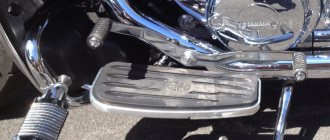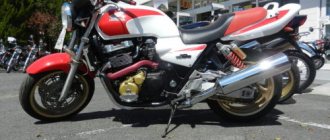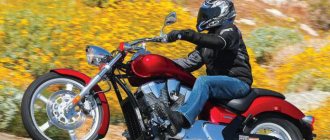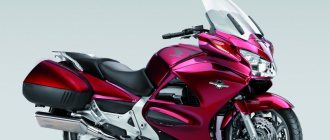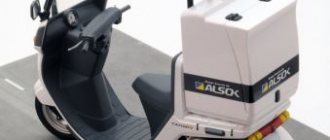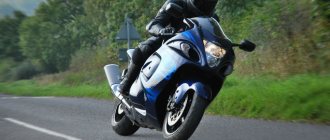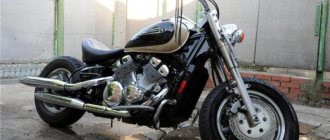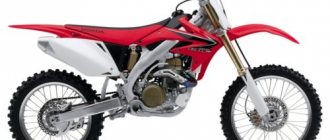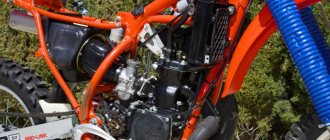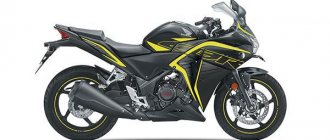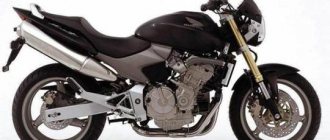Sports tourer ST 1300 Pan European, Honda presents in 2002 . It should become a logical continuation and successor to the ST 1100 model, released 12 years earlier .
But, despite the more modern filling and new production technologies, the model fails to beat the record of its parent. However, this did not prevent its release and sale for 14 years .
The model leaves the assembly line in 2016 , but the new successor will not be the Pan European 1500 or 1800, as was the case with the older model (the legendary Gold Wing). The continuation of the line is the Honda STX 1300 , as a more comfortable and modern version of the “European”. At the same time, the ST 1300 becomes the latest reincarnation of Pan European. In 2016, a decision was made to permanently close the line.
Specifications
Already from the very beginning of production, the new bike receives an injector, a cast aluminum frame, and a chain valve drive.
| Honda ST 1300 Pan European | Parameter |
| Motorcycle type | sports tourist |
| Year of release | 2002-2016 |
| Frame | aluminum cast |
| engine's type | 4-cylinder, 4-stroke, chain valve drive, V-shaped, 1261 cm³, 126.0 hp, liquid cooled, injector |
| Number of valves per cylinder | DOHC chain driven, 4 valves per cylinder |
| Ignition type | transistor |
| Transmission | 5-speed manual |
| Drive unit | gimbal |
| Front tire size | 120/70-ZR18 M/C (59W) |
| Rear tire size | 170/60-ZR17 M/C (72W) |
| Front brakes | 2 discs, 310 mm, 3-piston calipers (combi-brakes) |
| Rear brakes | 1 disc, 316 mm, 3-piston caliper (combi-brakes) |
| ABS | OPTION |
| Front suspension | 45 mm telescopic fork, travel - 108 mm |
| Rear suspension | pendulum with monoshock absorber (5-step preload adjustment), stroke - 123 mm |
| Motorcycle length | 2270 mm |
| Motorcycle width | 860 mm |
| Motorcycle height | 1390-1630 mm |
| Wheelbase | 1,490 mm |
| Seat height | 790 mm (adjustable +/-15 mm) |
| Minimum ground clearance (clearance) | 135 mm |
| Acceleration to 100 km/h | 3.5 sec |
| Maximum speed | 228 km/h |
| Comfortable cruiser | up to 160 km/h |
| Gas tank capacity | 29.0 l (up to 400 km) |
| Motorcycle weight (dry) | 283 kg |
| Motorcycle weight (curb) | 319 kg |
Otherwise, it is the same 4-cylinder , 4-stroke engine , of increased volume, which has proven itself well in the prototype.
If you take care of the Honda V4, make timely adjustments and purchase high-quality consumables, then there is no catch.
Transmission and clutch
The motorcycle received a 5-speed gearbox . But, unlike the previous model, where traction control was offered to help the pilot, it was not installed here.
There were no other complaints from users - the gears were engaged immediately, the neutral was in the usual place, the foot travel was within average limits.
Boxes of early versions suffered from second gear overshoot. Spare parts are relatively inexpensive, but to replace it you will have to completely dismantle the engine.
When asked about traction control, the developers answered - it is impractical, since adjustment requires special maintenance, and besides, installing it will raise the price of the bike to the level of the older model - Gold Wing.
The main drive is a cardan , as is customary with the line.
Brakes
According to user reviews, the bike's brakes are good. But what’s unusual is that the diameter of the rear disc is BIGGER than the front – the difference is insignificant, only 6 mm, but it attracts attention.
The combined brakes installed on the bike have a rather complex mechanism that requires full maintenance of the system at each service.
Traditionally, there are two discs in front and one in the rear . The support brackets on both axles are unified - designed for three pistons. Rotor diameter - 310/316 mm .
The motorcycle has combi-breaks (both are activated when one is engaged). The user could receive ABS .
It was not offered in stock - an option.
Story
1991 Honda ST1100
In 2000, during the motorcycle show season, Honda began preparing the public with its sport-touring prototype, which had a 1500 cc V6 engine, single-sided front and rear suspension and an automatic transmission. The project, called the X-Wing, was rumored to replace the Honda ST1100 (Honda's sport-touring machine produced since 1990) and this partly happened because in 2002, Europe and Australia welcomed the all-new ST1300 Pan-European bike. For the US market, the new motorcycle was to be imported in limited numbers starting in 2003 as the ST1300. The 500 or so models for the year were off to a good start (they had many of the flowing lines of the X-Wing bike, but nothing on the chassis side).
Power was generated by a 1,261-horsepower V4 engine mounted quite low in a lighter aluminum frame. What really differentiated the new bike from the ST1100 was the use of balancer shafts, which ensure smooth operation and allow the engine to be mounted directly to the frame. The mass of the new modified engine was concentrated at the bottom, giving the ST1300 greater stability than its predecessor. Huge power reached the rear wheel through a cassette-type five-speed transmission and driveshaft, requiring minimal maintenance and built to last for many miles.
Owners of the 2002 models reported that their machine began to wobble at speeds above 100 mph, a very important problem that caused Honda to stop production of the 2003 motorcycles. A fair number of 2002 bikes were recalled to replace some chassis parts (a fix that was made to the early 2003 models on the production line).
Another problem also led to the return of 2002 models with an upgraded oil pan, as some bikes were leaking oil after encountering road obstacles such as speed bumps.
The bikes recalled because of the first two problems also got rid of a wire that rubbed against the frame and damaged the fuse, preventing the engine from starting.
With all the issues resolved and a high quality product more reliable than ever, it was ready to hit the American market in style and style, using its sleek lines and carefully chosen colors to stand out.
In its first year of production (2003 for the US market), the Honda ST1300 appeared in a beautiful silver "garb", which was replaced by blue in 2004 and red the following year.
The fourth year of production of the bike was marked with a black design, but 2007 soon came and “demanded” metallic silver.
2000 Honda X-Wing prototype
Competition
Competition
2009 Yamaha FJR1300A
Yamaha is also emerging as a contender for the supersport touring championship, as its 2008 FJR1300A features a light aluminum frame engine that produces 145 horsepower. A new, scratch-resistant, hard windshield cover along with a new windshield holder design and new handles prove the perfection of this bike and increase the distance between it and the average sport tourer.
We all know that Honda's machine is no ordinary machine, and although Yamaha has provided a push-button adjustable windshield and a thick comfortable saddle for two, an advanced air control system and an adjustable body, Honda will not give up its crown so easily, which can only mean that the race is long distance still far from finished.
In fact, with the 2008 Kawasaki Concours14 bike featuring a thrilling performance engine, impeccable handling and a comfortable riding position with driveshaft, securely locking luggage racks, electrically adjustable windshield and a host of other accessories to create the most impressive high-speed long-distance machine on the market today, race supersport tourists have just begun.
2009 Kawasaki Concours1400
Appearance
Exterior
2009 Honda ST1300
As a touring machine, the ST1300 features an aluminum die-cast body, a three-position adjustable rider's seat and two large, removable 35-liter saddlebags. Everything on this bike screams touring, and the push-button, motor-driven windshield with height and angle adjustments is even more than you might actually need. It simply provides a luxurious appearance and significantly increases ride comfort.
To protect the bike's excellent plastic finish, the guards have been extended in case the bike tips over. Rearview mirrors also help minimize damage should the bike fall, but a proud owner will no doubt take good care and equip his friend with emergency systems designed to protect the bike from theft and from simply falling over.
Eye-pleasing accessories with aerodynamic styling create a fluid exterior design. Everything fits together perfectly, from the headlights, gas tank, and well-designed panniers.
The 2008 model is available in deep red, making the design features truly impressive.
—-
Driving performance
Unlike the prototype, the maximum speed of the new product is 228 km/h . The owners say that, thanks to the excellent wind protection, it is possible to dial it in, but it is not very comfortable to ride. Therefore, a comfortable cruiser is 100–160 km/h .
Acceleration (dynamics)
Acceleration from zero to 100 km/h in 3.5 seconds . According to user reviews, “it’s quite possible to play catch-up” with other bikers.
Fuel consumption
The consumption stated in the documentation is 6.21 liters per 100 km . Users note - up to 6 liters on the highway. And in the city you can see 10 liters . It all depends on your driving style. Provided that the motorcycle’s tank is larger than that of the legendary “big brother” - 29 liters (versus 24 liters ), the average distance at one gas station is up to 400 km .
Appearance and dimensions
Honda Pan 1300 has quite standard dimensions for a vehicle of this type.
The motorcycle is 2.27 meters long, almost 0.9 meters wide and 1.4 meters high. The wheelbase is 1490 mm.
The gas tank capacity is 29 liters (including a five-liter reserve).
As for the appearance, it is quite laconic. The ergonomic design of the bike will not leave true motorcyclists indifferent.
The capacity of the model 1300 Pan Europe is two people, a driver and a passenger.
Quite low seating position, which provides driving comfort and a better feeling of the road.
Modifications
As happened with the previous model, in 2005 the ST 1300 Pan European Police modification appeared - a model for traffic police .
Honda ST-1300 Pan European Police - police version.
However, it was not as brightly colored as those previously produced, so it was widely used not only by authorities, but also by many simple municipal services. No other developments were made.
In 2013, work begins on the STX 1300, the future successor.
and competitors
The motorcycle was not left without competitors either. They didn’t bother with the police version, but for the tourist they provided:
- Yamaxa offered the FJR 1300 , an updated FJ 1200 . Start of production in 2001 , completion in 2016 .
- Kawasaki came out with a slightly larger model - 1400 GTR . Due to the launch of it already in 2007 , he studied the problems of competitors, and continues to assemble it today.
Available versions
I've chosen to base my reviews on standard cars since they usually sell best and get the most miles, but that's not the case since the "touring" designation comes with optional Anti-lock Braking System (ABS) and the resulting safety.
Honda ST1300 ABS
Honda ST1300 ABS
2009 Honda ST1300ABS
Honda has designed the ABS version of the ST1300 as a motorcycle equipped with a smart system that combines with LBS (Linked Braking System) for greater control over the brakes and steering. The result is a latest generation system developed by Honda specifically for this type of car.
Competition
Competition
2009 Yamaha FJR1300AE
It's quite normal for an ABS version of a motorcycle to compete with the ABS versions of the bike's competitors, and since Yamaha offers the system as standard equipment, that leaves only Kawasaki. With the Concours14 ABS, Kawasaki offers incredible performance plus superb stopping power. As the race between the three continues, we can only be confident and supportive in our expectations for the grand finale, locked wheels are out of the question!
2009 Kawasaki Concours1400ABS
Test Drive
I also had the opportunity to enjoy the ST1300's amenities and ABS handling, and noticed that the bike was only sporty on the ABS version, as I had to press hard on the brake lever and pedal. If you also want to test the braking capabilities of a motorcycle, then you must take into account its size and weight. I recommend choosing a straight road without traffic and then gradually but still firmly applying pressure to the brakes until you get used to the bike's response and feel. After several attempts, you can try them to their fullest and see how ABS works on a motorcycle.
Peculiarities
“Pan-Europe” is loved for its fantastic reliability, low maintenance costs and driving performance that provides comfort both in city traffic and on long-distance travel.
Interestingly, the differences between the motorcycle include mainly ergonomic indicators.
- The valve drive became a chain drive (versus the belt drive of the prototype).
- The windshield is either fixed in one position or variable in height (in the latter case there was a choice between manual or electric drive).
- Suspension travel became longer, and thicker material was used for the fork feathers.
Rear suspension – with 5-step preload adjustment.
- The pilot could adjust the height of the saddle
- The height of the mirrors - due to changes in the overall height of the bike, they dropped to the level of the ears of passenger cars, which created problems for those who like to rush along the aisles
There is no need to mention excellent controllability and maneuverability - motorized battalions have higher demands on the quality of their “horses”.
Test Drive
2005 Honda ST1300
2003 Honda ST1300
The level of performance found in the Honda ST1300, also known as the Pan European, would rank at the very top of any chart, with comfort and handling having the highest priority when designing this touring machine.
One of the few works of art in the touring world, Honda's acclaimed ST1300 covers long distances while delivering the best combination of exhilarating performance, responsive handling and limousine-worthy levels of comfort.
The sleek, aerodynamic body, unique three-way, height-adjustable rider saddle and push-button adjustable windshield ensure that any biker will feel complete comfort and satisfaction behind the wheel of this machine.
As the miles rack up and confidence builds, the biker can use the powerful fuel-injected V4 engine, advanced aluminum frame, high-performance sport suspension and linked braking system to truly enjoy the thrill of pumping adrenaline through the roof. your body.
The ST1300 is a true confidence builder and from the first metres, it comes across as a very capable capable tourer, delivering exceptional performance and precise handling. The Pan European is an original bike, from its unique engine configuration to its rugged chassis, body and integrated panniers, everything about this bike is designed to function like a happy dream, as reliability is one of its best qualities.
Honda ensured that their new creation would be a real torque generator, revving like a sportbike, by creating a 1261cc V4 engine and placing it in-line in the frame. The frame itself is an aluminum construction, and an aluminum swingarm completes the overall package, offering a comfortable ride.
Comfort is achieved through the perfect combination of saddle and windshield. At the touch of a button, you can raise or lower the windshield and adjust the angle within a range of 13 degrees. The comfortable, supportive saddle has three levels of height adjustment as well as length adjustment.
Price
They say that luxury comes with a price, but in the case of the new Honda ST1300 motorcycle, plenty of people will be riding in complete comfort and great satisfaction as this sport tourer is offered at a retail price of just $14,499.
When you pay, don't forget that you are guaranteed to enjoy Honda's heritage and the experience gained in creating the famous ST1100 bike. You will be riding not just in a sports touring car, but in a living legend.
Conclusion
Overall, the package offered by Honda is completely extraordinary. What I came across was an impeccably designed motorcycle that combines impressive exterior design with comfort, handling and performance.
I haven't driven a Honda in quite some time and I have to say that my excitement was completely justified and the rewards were greater than I expected. The ultimate touring machine and the definition of comfort now has a new name: the Honda ST1300.
—-
Competitors
Even though the Pan European was supposed to be the wing's equivalent, Yamaxa and Kawasaki .
Yamaxa GTS 1000.
Kawasaki GTR 1000.
- GTS 1000 in 1993 . It was distinguished from the Pan European by a smaller engine capacity (but higher maximum speed), a standard chain drive, adjustable footrests and fuel injection.
- Kawasaki presented its version of the GTR 1000 earlier than Honda. It did not have ABS, 4 cylinders were arranged in a row, which gave a slight increase in horses (110), had a 6-speed gearbox, and completely indecent fuel consumption - 7 liters for the extra-urban cycle.
Design
The design of this bike from the manufacturer Honda is distinguished by its reliability and high build quality.
The motorcycle also has simple but very useful options - adjusting the wind lift and the driver's seat. Thanks to such implementations, any trip, including motorcycle tourism, will be easy and without problems.
The bike has a durable and wear-resistant body
The bike body is as durable and wear-resistant as possible, because it is made only from high-quality materials. The manufacturer provided for various possible situations and added steel arches to the Honda ST1300 Pan model. They provide additional protection, for example, in case of a fall.
The design includes luggage compartments for more convenient placement of personal items while traveling.
Tire selection
In the context of tires with the BMW R 1200 RT, everything is crystal clear from the start. 120/70-R17 and 180/55-R17 are some of the most popular sizes. The standard wheel sizes on the ST1300, although rare in themselves, are not unique. Before 120/70–18 it was installed on the Honda CB1000 and X4, as well as on the Yamaha TDM900 and Warrior. As for the rear 170/60-17, it's clearly early 90s with "tourers" like the CBR1000F and GPZ1100, as well as the more recent BMW R 1150 RT. Wheels in these sizes are still produced, and what’s more, there are plenty to choose from.
You need to look among sports and touring models, giving preference to reinforced versions, designated differently by different manufacturers. More specifically, it will be Pirelli Angel GT, Metzeler Roadtec Z8 Interact, Michelin Pilot Road 4GT, ContiRoadAttack 2 EVO GT, Dunlop Roadsmart III. They will be expensive, about 20,000 rubles per set, but will provide excellent grip on both dry and wet asphalt and a long service life.
Those who want to save a little can turn their attention to previous models of sports and touring tires that are still in production. These are Metzeler Roadtec Z6, Michelin Pilot Road 3, Conti Road Attack, Dunlop Roadsmart 2. This group also includes the Korean tires Shinko Verge Radial 011, which can also be put on the “Pan-Europe” due to poverty. Such a kit will cost less, but you will lose grip properties and service life at the same time, so in rubles per kilometer it will be the same. Still, tire manufacturers are making progress, and the difference between different generations of tires from the same manufacturer is strongly felt.
Another way to save money is to install “chopper” tire models. In this size you can find the Metzeler ME880 Marathon and Michelin Scorcher with the Harley-Davidson logo on the sidewalls (Michelin will have the rear wheel size from H.-D. Dyna - 160/70). Such wheels exceed factory requirements in terms of load indices; they are more rigid in their frame and “oak” in composition of the rubber mixture. They last a really long time, but you will have to drive them more carefully - they will not provide grip properties at the level of sports touring tires.
I would dissuade you from installing the more common 180/55 wheel backwards.
Firstly, it does not “mushroom” well on the five-inch rear disc, and as the inclination increases, the contact patch of the rear wheel decreases, and secondly, it is lower than 170/60, which leads to more frequent damage to the disc on bumps and earlier contact of the footpegs with the ground when cornering. So 170/60, no wider needed. www.motorezina.ru Opening up! > April 25, 2021 11:00 Mikhail Pimus
Who is it suitable for?
Gold Wing and Pan European ST 1100 sell out like ice cream in the summer, but not everyone will find it comfortable, although the sofa they come with will, by definition, be comfortable.
Typically, this motorcycle is purchased for comfortable travel over really long distances.
At the same time, the ST 1100 was designed for a European of average height and a classic, slightly forward-leaning seating position.
Reviews
The most frequently cited disadvantages of the model were:
- a weak generator , which was barely enough for the bike’s own electrics. (In 1995 it was replaced with a more powerful one).
- mounting of mirrors , which had to be modified so as not to buy new ones.
- weak rear shock absorber not designed for traveling with two people with full standard panniers.
Rod wear and corrosion is another fairly common rear shock problem.
Like any other model, individual owners could cite more disadvantages for each specific unit.
Advantages
The advantages of the motorcycle included both technical and external advantages.
- powerful, indestructible motor;
- soft and clear gearbox;
- cardan;
- comfortable, large seat;
- classic landing (slightly tilted forward);
- similarity to Gold Wing;
- illumination, like Gold Wing.

